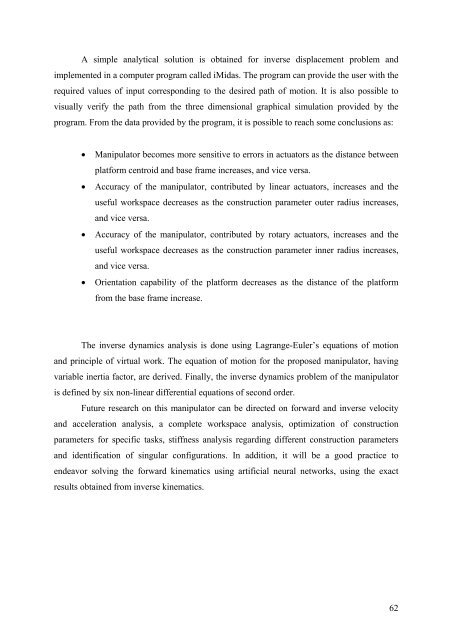Kinematic and Dynamic Analysis of Spatial Six Degree of Freedom ...
Kinematic and Dynamic Analysis of Spatial Six Degree of Freedom ...
Kinematic and Dynamic Analysis of Spatial Six Degree of Freedom ...
You also want an ePaper? Increase the reach of your titles
YUMPU automatically turns print PDFs into web optimized ePapers that Google loves.
A simple analytical solution is obtained for inverse displacement problem <strong>and</strong><br />
implemented in a computer program called iMidas. The program can provide the user with the<br />
required values <strong>of</strong> input corresponding to the desired path <strong>of</strong> motion. It is also possible to<br />
visually verify the path from the three dimensional graphical simulation provided by the<br />
program. From the data provided by the program, it is possible to reach some conclusions as:<br />
• Manipulator becomes more sensitive to errors in actuators as the distance between<br />
platform centroid <strong>and</strong> base frame increases, <strong>and</strong> vice versa.<br />
• Accuracy <strong>of</strong> the manipulator, contributed by linear actuators, increases <strong>and</strong> the<br />
useful workspace decreases as the construction parameter outer radius increases,<br />
<strong>and</strong> vice versa.<br />
• Accuracy <strong>of</strong> the manipulator, contributed by rotary actuators, increases <strong>and</strong> the<br />
useful workspace decreases as the construction parameter inner radius increases,<br />
<strong>and</strong> vice versa.<br />
• Orientation capability <strong>of</strong> the platform decreases as the distance <strong>of</strong> the platform<br />
from the base frame increase.<br />
The inverse dynamics analysis is done using Lagrange-Euler’s equations <strong>of</strong> motion<br />
<strong>and</strong> principle <strong>of</strong> virtual work. The equation <strong>of</strong> motion for the proposed manipulator, having<br />
variable inertia factor, are derived. Finally, the inverse dynamics problem <strong>of</strong> the manipulator<br />
is defined by six non-linear differential equations <strong>of</strong> second order.<br />
Future research on this manipulator can be directed on forward <strong>and</strong> inverse velocity<br />
<strong>and</strong> acceleration analysis, a complete workspace analysis, optimization <strong>of</strong> construction<br />
parameters for specific tasks, stiffness analysis regarding different construction parameters<br />
<strong>and</strong> identification <strong>of</strong> singular configurations. In addition, it will be a good practice to<br />
endeavor solving the forward kinematics using artificial neural networks, using the exact<br />
results obtained from inverse kinematics.<br />
62
















